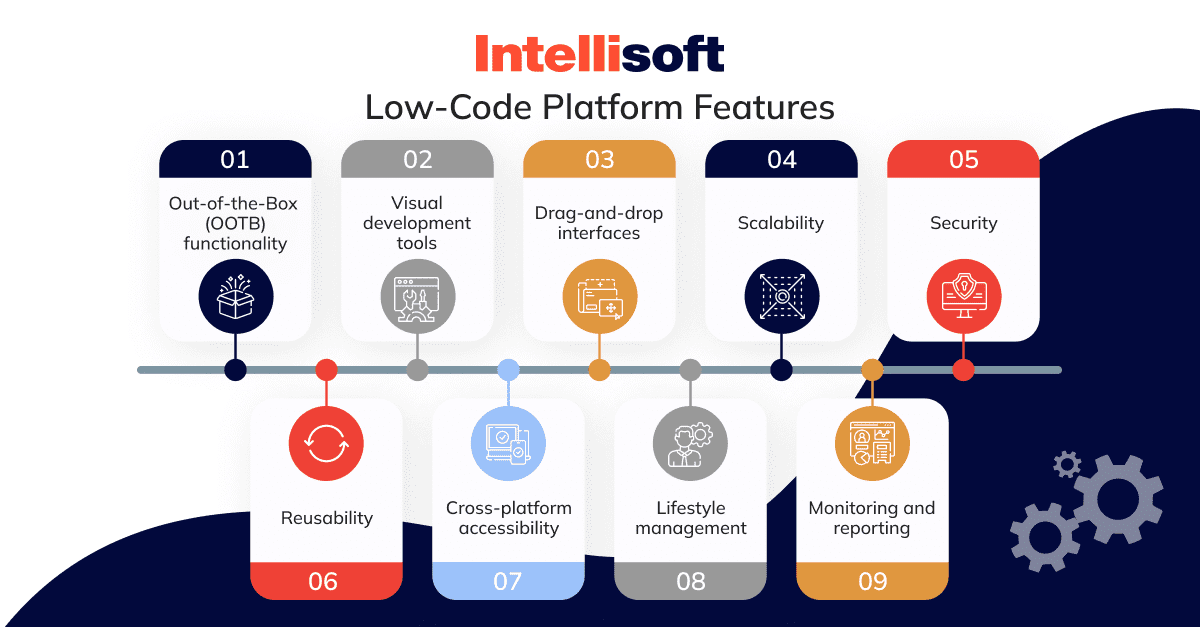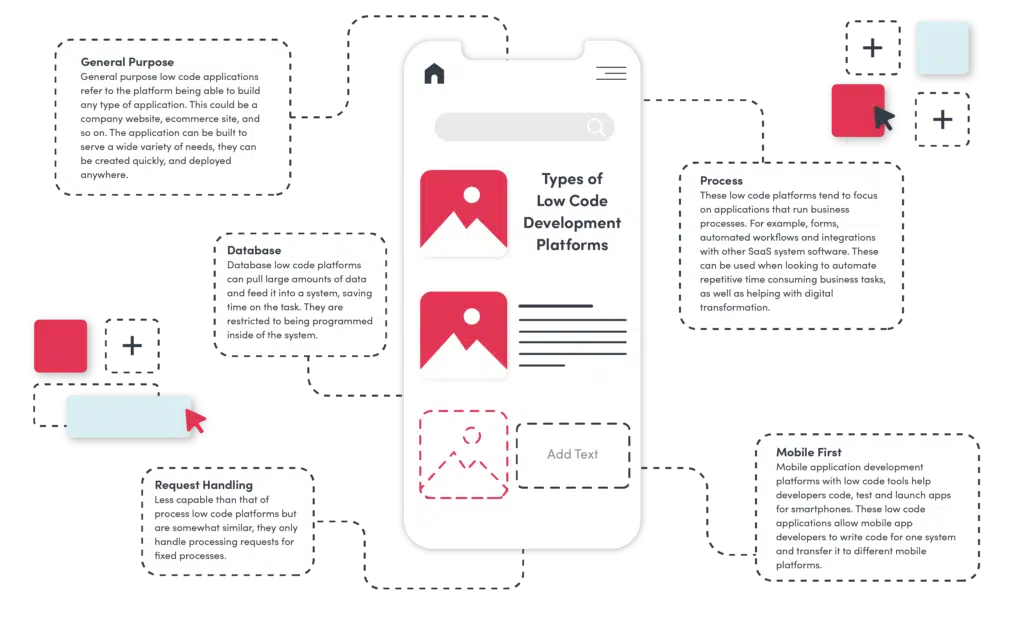New Ideas For Selecting application development with Low-code platforms
Wiki Article
Advantages Of Low Code Application Development In Relation To Integration Capabilities
Low-code application integration offers many advantages, including the ability to seamlessly integrate with different applications and systems. Here are a few of the principal benefits: pre-built connectors and APIs.
Wide Variety of Connectors Low-code platform typically comes with a library of prebuilt connectors for the most popular enterprise software (e.g. CRMs, databases, ERPs, cloud services). The process of integrating these systems is made much easier.
API Integration: Many platforms have built-in API integration features. This lets developers quickly connect to external data and services.
Usability:
Drag-and-Drop Integration: A variety of integration tasks are performed by using drag-and-drop interfaces. This lets developers and nondevelopers to create complex integrations with little or no code.
Visual Workflow Builders : Tools for creating workflows and data flow which are visualized help understand and set up integrations in a more intuitive manner.
Standardized Integration Methods:
SOAP and RESTful Services Support for standard web services protocols like SOAP and REST allows for simple integration with a array of external systems and applications.
OData Standards: OData standards allow for easy manipulation and accessibility of data across various platforms and apps.
Real-Time Data Synchronization:
Real-time Integrations: Low-code platforms are able to handle real-time data sync between applications and systems, assuring that the data is always current and uniform across the entire organization.
Event-Driven Architectures: A few platforms have event-driven architectures which enable applications to respond in real-time whenever certain events happen, which is essential for dynamic applications.
Legacy System Integration:
Low-code platforms are often used to integrate legacy systems. This lets organizations modernize IT infrastructures without the need to completely overhaul the existing systems.
Data Migration Tools - Built in data-migration tools make it simple to move data from old systems to low-code applications.
Integration of Third Party Services:
Cloud Services Integration: The seamless integration of cloud services, such as AWS Azure, Google Cloud, allows for easy deployment and scaling up of applications.
Business Applications Integration: Low-code platforms are able to integrate with different business applications, such as Salesforce, SAP, Microsoft Dynamics and more. to create a seamless workflow that spans different business tasks.
Simplified Data Management:
Unified Data models: Certain low-code platforms offer unified data modeling that simplifies data integration and management across different platforms.
Data Connectors - Pre-configured connectors which provide easy access to, and manipulation of, data from a variety of sources.
Security and compliance:
Secure Integrations - Low-code platforms have been designed to ensure that all integrations conform to security standards and protocols. This helps protect the data in transit as well as when it's stored.
These platforms are typically equipped with features that help ensure conformity (e.g. HIPAA, GDPR) and provide peace of mind to businesses dealing with sensitive data.
Extensibility:
Low-code platforms allow for the use of customized scripts and code to satisfy more complicated integration requirements. The flexibility offered without compromising user-friendliness.
Plug-in Ecosystems. A community of extensions and plug-ins allows you to further enhance the capabilities of integration, while adding additional functions as needed.
Overall, the low-code platform's capabilities for integration make it a powerful instrument for creating interconnected applications that are scalable and efficient. They streamline the process of linking disparate systems. They enhance data flow, and enable enterprises to use existing technologies while adopting new ones, thus ensuring the integration of a seamless IT environment. Check out the most popular Low-code Platform for application development for website examples including develop cross platform mobile app, develop mobile application, stored sql procedures, push notifications, cross platform app development, rad application development, jdbc server, driver jdbc, rad application development, rad application development and more.

Low-Code Application Development Offers Many Benefits In The Area Of Cost-Effectiveness.
Low-code app development offers a number of benefits, including cost efficiency. This is a great option for businesses who want to reduce development costs without compromising on quality. These are the main benefits:
Lower requirements for coding: Low codes platforms remove the need for extensive hand-coded, custom-built applications. Developers will spend less time and effort building applications. This also results in lower costs for labor.
We require fewer resources for developers: Programming with low-code is faster and easier which means that fewer developers with specialized skills are needed. This can cut down on the costs of staffing and hiring.
Speedier Time to Market:
Rapid development process Visual development tools and prebuilt components provided by low-code platforms facilitate rapid development of applications. This allows companies to bring their products to market quicker. This can translate into increased revenue as well as improved competitive positioning.
Rapid Prototyping. By quickly creating and testing prototypes, companies can cut down on time spent development and improve their product faster based on feedback from users.
Reduce Maintenance Costs
Simpler Maintenance: Low-code platforms with their standardised components and modular architecture, are easier to maintain. This means that they are less likely to require ongoing maintenance and support costs.
Automated Updates: A lot of low-code platforms handle patches and updates automatically, ensuring applications remain secure and up-to date without needing large manual intervention.
Efficient Resource Utilization:
Non-Developer contributions: Low code platforms enable non-developers like business users, to contribute to the process of development. This democratization of development processes allows businesses to utilize the skills and expertise of a greater variety of employees.
Improved utilization of IT resources IT departments get the ability to focus on more strategic initiatives, instead of being bogged-down with mundane work tasks for development. Overall productivity and efficiency improves.
Scalable Pricing Models
Subscription-Based Pricing: A lot of low-code software providers offer flexible subscription-based pricing plans that grow with the amount of usage. Businesses are able to adjust their spending in line with their growth and needs, without incurring large upfront costs.
Pay-Assosiated Option: A few platforms provide pay-assosiated choices. They ensure that businesses are only liable for the services utilized, which is beneficial to startups and small business that have limited resources.
Reduced Third-Party Software costs:
Built-in Functionalities: Low-code platforms come with many built-in features and integrations, which make it less necessary to use third-party tools and software. License and subscription charges are also reduced.
Integrations pre-built: These systems and services can be integrated with other well-known services, reducing the need for custom-developed software, which saves time and cost.
Increased ROI
Faster Return on Invest Rapid development: By combining lower costs and a faster speed to market, companies are able to get a higher return on their investments (ROI).
Enhanced Agility - Businesses can quickly adapt to changes in market and to changing customer demands. This allows them stay current and take advantage of opportunities that arise.
Train for Less:
User-Friendly Interfaces: Low-code platforms offer intuitive and easy-to-use interfaces that reduce the learning curve.
Accessible resources: Many low-code platforms have complete tutorials, instructional materials, as well as community support and help, which can reduce the need for formal education.
Collaboration is made easier:
Improved Collaboration Tools: Built-in collaboration tools aid in better coordination and communication between team members, resulting in more efficient development processes and reduced project overhead.
Unified Development Environment. A single unifying software development environment can simplify processes and decrease the cost and complexity of managing different platforms and tools.
Low-code development is cost-effective because it decreases maintenance and development expenses. It also speeds up time to market and optimizes resource usage. Pricing models are flexible. These elements combine to provide significant financial benefits for businesses and make low-code development a viable choice for businesses looking to increase their budgets for development while achieving high-quality, flexible and top-quality applications. Check out the top additional resources on Legacy application modernization with Low-code for blog info including app modernisation, application development platforms, application development platforms, build a docker container, push notifications android, app modernization, rapid applications, no code platforms, push alerts, jdbc server and more.

Advantages Of Low Code Application Development In Terms Of Specifications And Customization
The low-code approach offers a balanced method that permits significant customization and addresses weaknesses. Here are the key benefits:Handling the limitations
Overcoming Complexity:
Low-code platforms facilitate development by providing pre-built templates and components. This allows for faster deployment and development of complex applications.
Many platforms have guided workflows, which assist developers navigate their way through the complex procedures. They decrease the chances of making mistakes and help maintain uniformity.
Scalability solutions:
Scalability is built into low-code platforms. They typically have features that enable scalable architecture. This enables applications to handle higher loads without requiring significant redevelopment.
Performance Monitoring: Using instruments for monitoring performance optimization, tuning and monitoring help applications scale efficiently.
Security and Compliance:
Security features integrated into low-code platforms have security measures such as encryption, role-based control of access and automated compliance checks, which address common security concerns.
Platforms update frequently their security protocols and ensure compliance with regulatory requirements. This keeps platforms safe from new threats.
Customization Features:
Extensibility:
Custom Code Integration: Low-code systems typically permit the integration of custom code (e.g., JavaScript, Python), enabling developers to enhance the functionality beyond the basic features.
Customized plugins and modules Developers can design custom plugins or modules to add specific functionalities tailored to unique business requirements.
APIs and Integration
API Support: The extensive API support permits seamless integration of services and systems from outside. This enables the ability to customize and connect.
Third-Party Services: Low code platforms have connectors designed to work with popular third-party services. This makes it much easier to build and integrate applications.
Flexible UX/UI:
Customizable user interfaces: Developers can modify and design the user interfaces so that they fulfill specific branding requirements as well as usability needs, providing the user with a customized experience.
Responsive design: The capability to adapt applications to different devices and screens is built-in.
Making Business Logic more flexible is simple:
Visual Workflow Designers: These graphic tools can be used to customize and create workflows, as well as business logic, allowing programmers to develop complex, custom-designed processes.
Platforms include conditional Logic that allows the development of custom scripts to address specific scenarios and business rules.
Data Management:
Custom Data Modelling: Those who develop the models develop custom models to meet specific application needs. They can customize processing of data according to a company's requirements.
Advanced Data Processing : Integration with sophisticated tools and capabilities to process data allows flexibility in the way data is analysed, and used within your application.
How to balance customisation with limits:
Frameworks and Standards
Low-code platforms support the use of industry-standards and best practices, resulting in applications of high-quality that are robust and secure.
Governance Frameworks Inbuilt governance frameworks will ensure that customizations do not compromise the integrity, security, or compliance of the software.
Iterative Development:
Rapid prototyping: Developers are able to quickly prototype and test customizations based on the feedback of users, and improve the app according to their requirements.
Continuous Improvement: Low code platforms permit constant improvements. They are able to be modified and customized as business needs change.
User Empowerment
Giving Citizen Developers the ability to be empowered: By giving non-developers the ability to personalize their apps using easy-to-use interfaces and low-code platforms they increase the number contributors who are able to enhance and tailor application.
Training and support: Many platforms include extensive training resources and support services to assist users with making customizations that are effective without compromising the application's performance or stability.
Overall, Low-code application creation offers a framework that is strong and adaptable enough to meet restrictions while allowing the possibility of extensive customization. This allows companies to create and maintain applications that work and tailored to meet specific business requirements. All while maintaining high quality, security, scalability, and standards.
